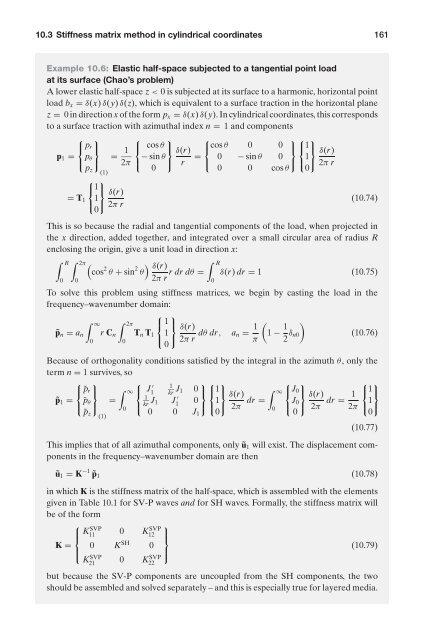Eduardo Kausel-Fundamental solutions in elastodynamics_ a compendium-Cambridge University Press (2006)
You also want an ePaper? Increase the reach of your titles
YUMPU automatically turns print PDFs into web optimized ePapers that Google loves.
10.3 Stiffness matrix method <strong>in</strong> cyl<strong>in</strong>drical coord<strong>in</strong>ates 161<br />
Example 10.6: Elastic half-space subjected to a tangential po<strong>in</strong>t load<br />
at its surface (Chao’s problem)<br />
A lower elastic half-space z < 0 is subjected at its surface to a harmonic, horizontal po<strong>in</strong>t<br />
load b x = δ(x) δ(y) δ(z), which is equivalent to a surface traction <strong>in</strong> the horizontal plane<br />
z = 0 <strong>in</strong> direction x of the form p x = δ(x) δ(y). In cyl<strong>in</strong>drical coord<strong>in</strong>ates, this corresponds<br />
to a surface traction with azimuthal <strong>in</strong>dex n = 1 and components<br />
⎧<br />
⎧ ⎫ ⎧<br />
⎫ ⎧ ⎫<br />
⎨<br />
p 1 =<br />
⎩<br />
p r<br />
p θ<br />
⎫<br />
⎬<br />
⎭<br />
p z (1)<br />
⎫<br />
= 1<br />
2π<br />
⎧<br />
⎨ 1⎬<br />
δ(r)<br />
= T 1 1<br />
⎩ ⎭ 2π r<br />
0<br />
⎨ cos θ ⎬<br />
− s<strong>in</strong> θ<br />
⎩ ⎭<br />
0<br />
δ(r)<br />
r<br />
⎨cos θ 0 0 ⎬ ⎨1⎬<br />
δ(r)<br />
= 0 − s<strong>in</strong> θ 0 1<br />
⎩<br />
⎭ ⎩ ⎭ 2π r<br />
0 0 cos θ 0<br />
(10.74)<br />
This is so because the radial and tangential components of the load, when projected <strong>in</strong><br />
the x direction, added together, and <strong>in</strong>tegrated over a small circular area of radius R<br />
enclos<strong>in</strong>g the orig<strong>in</strong>, give a unit load <strong>in</strong> direction x:<br />
∫ R ∫ 2π (<br />
) ∫ δ(r)<br />
R<br />
cos 2 θ + s<strong>in</strong> 2 θ<br />
0 0<br />
2π r rdrdθ = δ(r) dr = 1 (10.75)<br />
0<br />
To solve this problem us<strong>in</strong>g stiffness matrices, we beg<strong>in</strong> by cast<strong>in</strong>g the load <strong>in</strong> the<br />
frequency–wavenumber doma<strong>in</strong>:<br />
⎧ ⎫<br />
∫ ∞ ∫ 2π ⎨ 1 ⎬<br />
δ(r)<br />
˜p n = a n r C n T n T 1 1 dθ dr,<br />
0 0 ⎩ ⎭ 2π r a n = 1 (<br />
1 − 1 )<br />
π 2 δ n0<br />
(10.76)<br />
0<br />
Because of orthogonality conditions satisfied by the <strong>in</strong>tegral <strong>in</strong> the azimuth θ, only the<br />
term n = 1 survives, so<br />
⎧<br />
⎧<br />
⎧ ⎫<br />
⎧ ⎫<br />
⎧ ⎫<br />
⎨ ˜p r<br />
˜p 1 = ˜p<br />
⎩ θ<br />
˜p z<br />
⎫<br />
⎬<br />
⎭<br />
(1)<br />
=<br />
∫ ∞<br />
0<br />
1<br />
⎨ J<br />
1<br />
′ kr J ⎫<br />
1 0 ⎬ ⎨1⎬<br />
∫<br />
1<br />
⎩<br />
kr J 1 J<br />
1 ′ δ(r)<br />
∞ ⎨J 0 ⎬<br />
0 1<br />
⎭ ⎩ ⎭ 2π dr = J<br />
0 ⎩ 0<br />
⎭<br />
0 0 J 1 0<br />
0<br />
δ(r)<br />
2π dr = 1<br />
2π<br />
⎨1⎬<br />
1<br />
⎩ ⎭<br />
0<br />
(10.77)<br />
This implies that of all azimuthal components, only ũ 1 will exist. The displacement components<br />
<strong>in</strong> the frequency–wavenumber doma<strong>in</strong> are then<br />
ũ 1 = K −1 ˜p 1 (10.78)<br />
<strong>in</strong> which K is the stiffness matrix of the half-space, which is assembled with the elements<br />
given <strong>in</strong> Table 10.1 for SV-P waves and for SH waves. Formally, the stiffness matrix will<br />
be of the form<br />
⎧<br />
⎪⎨<br />
K11 SVP 0 K SVP ⎫<br />
12 ⎪⎬<br />
K = 0 K SH 0<br />
(10.79)<br />
⎪⎩<br />
⎪⎭<br />
K21 SVP 0 K22<br />
SVP<br />
but because the SV-P components are uncoupled from the SH components, the two<br />
should be assembled and solved separately – and this is especially true for layered media.



